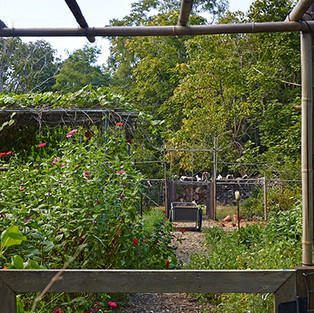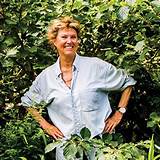
Here we are – mid-way into Women’s History Month & one year after the publication of The Earth in Her Hands.
In honor of these two thresholds, I offer out a conversation with one of the women in the book: Edwina Von Gal - a landscape designer based in New York’s The Hamptons. Having designed landscapes for the rich and famous - in terms of people and places along the lines of Rockefeller Center, Ina Garten, Calvin Klein, Robert De Niro and the artists Richard Serra and David Salle - it was midway through her career that Edwina had an epiphany about the potential impact for the better or worse in how gardens are cared for in our world.
In order to help tilt the balance back toward gardens large and small being positive contributors to the life, health, habitat and biodiversity of our world – she founded the Perfect Earth Project – promoting toxin-free lawns and landscapes for their people, pets, and planet.
In the last few years, Edwina has expanded her mission with advocacy known as 2/3rds 4 the birds – based on the research of Dr. Doug Tallamy – urging all residential and campus landscapes to dedicate 2/3rd of their plantings to be native plants for habitat value and to commit to going toxin free.
This is one woman’s garden life journey story reminding us it is never too late to do better and do more for what we value most. Below please find the profile of Edwina as excerpted from The Earth in Her Hands.
You can follow along with Edwina's work at Marsh House, for Open Days with The Garden Conservancy or classes held through The New York Botanical Garden through her Instagram: @edwinavongal/
Follow along with the laudable work - and to join them! - of The Perfect Earth Project online: perfectearthproject.org/
Follow along with the laudable work - and to join them! - of 234Birds online: www.234birds.org/
Listen in again next week when we visit with another remarkable woman horticulturist and learn more about another amazing land project – this one in the middle of downtown Chicago. We’re joined by horticulturist/gardener Laura Ekasetya, who was head of horticulture for a decade at The Lurie Garden in Chicago’s Millennium Park. Join us next week!
Edwina von Gal
(excerpted from The Earth in Her Hands, copyright 2020)
“One of the clients on any job of making a landscape is Nature.”
HER WORK:
Landscape Designer
Founder, Edwina von Gal + Co, Perfect Earth Project & 2/3rds 4 The Birds.org
East Hampton, New York
HER PLANT/LANDSCAPE:
“The view of Accabonac Harbor from my house. It’s a landscape in which I can’t, and don’t want to, change a thing. It is incredibly peaceful and beautiful every day, just as it is.”
HER PLANT JOURNEY:
Landscape designer Edwina von Gal has some very big name clients in her portfolio –The Channel Gardens at Rockefeller Center in New York City where she began her landscape design career, to the Biodiversity Park at the Biomuseo, (Museum of Biodiversity) designed by Frank Gehry in Panama City Panama. Her business, Edwina von Gal + Co, is known for its environmentally friendly, chemical-free, sustainable designs and includes clientele from around the world. Her non-profit advocacy organization, The Perfect Earth Project, “seeks to free the world” (and home owners and landscape professionals) of chemically-dependent landscapes one lawn at a time.
While Edwina’s own personal early gardening experiences were organically based, it was somewhere mid-career that Edwina as a landscape designer to an elite audience underwent a personal revelation about the direct connection between how ornamental landscapes are designed and cared for and their impact – negatively or positively – on the wider natural environment.
Edwina was born and raised in Brewster, New York “in an old farmhouse, surrounded by cow pastures and abandoned successional woodlands.” Her early gardening education was based on “obsessively reading garden catalogues,” being in her father’s vegetable garden and her grandmother’s flower borders, as well as “spending endless hours in the sandbox laying out neighborhoods, with roads and houses and little gardens.”
Edwina spent several college years pursuing biological sciences before marrying and starting a family, after which she “started gardening like a maniac – I gardened and gardened.” She grew all the food she could for her daughter, worked at a garden center, “and kept gardening and gardening.” After a divorce and beginning to raise her daughter on her own in Poughkeepsie, New York, Edwina took classes in garden design, horticulture, and architecture, with an eye toward pursuing her landscape architecture degree. In time, and after a few interactions with both architects and landscape architects, Edwina determined to be a landscape designer and began taking classes at the New York Botanical Garden. She earned her living by working for a well-known real estate developer, Peter Jay Sharp, in Manhattan and received an incredible “education on the go,” including a lot of experience in complex project management and interior and exterior design. She became known in the company as the “woman to go to with plant and landscape plans.”
In the late 1980s, Edwina went on an American Society of Landscape Architecture tour of New York City’s Channel Gardens at Rockefeller Center, and after asking a lot of questions about the site and the plants, she landed a job designing the gardens’ rotating and seasonal installations. One of her early installation concepts for the Channel Gardens included whimsical topiaries of African animals under planted with ornamental grasses to look like an African Savanna. This concept initiated the annual topiary shows at Rockefeller Center, and the first ornamental grass gardens there. For this installation she reached out to “The King of Grasses,” Kurt Bluemel (later known for working with Oehme, Van Sweden Landscape Architecture), and he dug “full size Miscanthus, Pennisetum and other grasses from his own garden.” On the day of the installation a Rockefeller Center executive called Edwina’s boss to say “what the heck is that mess of weeds you’re putting in out there, I want it gone.” And her boss replied, “ok, but there’s a story on that garden in the New York Times this morning…” The installation remained and received a lot of press.
With Peter Jay Sharp’s encouragement, Edwina launched her own landscape design firm, Edwina von Gal + Co in 1984. She grew her portfolio and clientele from up state New York to the Hamptons based on interesting plantings and beautiful designs, and she enjoyed collaborations with horticultural world contacts including Long Island City plantsman Mike Graham, New York Times garden writer and columnist Linda Yang, and plantsman David Murbach, who went on to become the permanent horticulturist at Rockefeller Center and founder of the Metro Hort Group, an association of professional horticulturists of which Edwina and Linda Yang were original members.
Awareness about environmental impacts of gardening came and went and came back again for Edwina. As a young “hippie mom she wouldn’t have dreamed of using chemicals on her vegetable garden.” As she transitioned into the professional design of mostly ornamental landscapes, she paid less attention to what was being applied on gardens once she had designed and installed them. Now, she understands more easily how people do not make the connection between all of the elements in their gardens and the wider environmental web of life. For her, this comprehension came as progression of deepening awareness starting with increasing love of the native plants of her home on Long Island. Then in 2002 Frank Gehry hired her to design landscapes around the Museum of Biodiversity (Biomuseo) in Panama City, Panama. Immersion in that project inspired her passionate advocacy for protecting Panama’s remaining biodiversity and her co-founding with Yale Forestry Ecologist, Ruth Metzel, and other like-minded friends, the Azuero Earth Project, an environmental non-profit devoted to sustainable land use, reforestation, organic agriculture and conservation of the dry forest of Panama’s Azuero Peninsula – all without chemical inputs.
It was on a trip home and visit to the dentist that Edwina had what she calls her “Dental Chair Epiphany” when her dentist remarked: “you know so much about this, can you help me manage a piece of land on the water here on Long Island without chemicals?” It clicked for her then that her passion for and knowledge of these practices (good ones and bad ones) was just as needed right in her own (figurative) back yard.
She began asking her existing clients about their contracts with maintenance companies, and what chemicals were being applied. Her clients mostly had no idea. She began going through their contracts and invoices and came to realize that massive amounts of chemicals were being dumped on their properties without their knowing or understanding. When she looked at what chemicals were being used she realized: “this is really, really bad.” She officially launched the Perfect Earth Project in 2013, on her 65th birthday.
Edwina understands that she began by speaking to a highly privileged group of people, but that they were also people with the resources and in decision--making positions that could make a real difference. “They are the pace makers, the trendsetters.” All of her clients were happy to have her advocate for this new direction and she reports that “their landscapes look more vibrant with the nature based maintenance.” She can’t overstate the results and her happiness with them.
“My landscape projects become increasingly focused on native plants and plant communities, and my work with Perfect Earth encourages people to become involved with the plant world in a way that looks at it as an integral part of our lives. There is so much astonishing new scientific information coming out about the microbiome, how it inhabits all of us, and provides a web of communication between all organisms to support their survival, it is like fairy tales, or science fiction, coming true. Of course the use of synthetic landscape chemicals completely disrupts these intricate systems. I am excited that so many people are now interested in learning about the role they can play and how I can help them to do so, working with ever more specialists who tremendously improve, inform and expand my designs. I am ever less afraid to let nature and plants make decisions for me.”
OTHER WOMEN to KNOW:
Lynden Miller, American Landscape Designer, responsible for the restoration of the public garden spaces in New York’s Central Park in the 1980s and 1990s.
Betsy Barlow Rogers, American Landscape designer, preservationist, and city planner, served as the first administrator for New York City’s Central Park. She is credited with revitalization of Central Park in the 1980 and 1990s.
Claudia West (see pg……), American Landscape Architect
Penny Lewis, Executive Director, Ecological Landscape Alliance, Sandown, NH
RELATED EPISODES INCLUDE:
Thinking out Loud this week...
One of the most important things I take away from this conversation with Edwina Von Gal is her own self awareness and willingness to keep learning, to keep getting better as the gardener and human she wants to be. There are plenty of people who in her position, working with the wealthy elite of her human community, finding relative fame and financial success, would stick to the formula and would not welcome or take meaningful action on an epiphany that told her she could be doing so much better.
And while in our moment in time it is perhaps easy to dismiss such privileged conditions as hopeless and hopeless parts of our many planetary problems, it feels so much more reasonable to expect these very conditions of privilege to keep learning. And not only to learn, but for all of us to leverage whatever privilege we may have in modeling meaningful change.
As Edwina points out in the course of our conversation it became clear to her that by getting one large overfed lawn and garden off of chemicals made a significant difference to the chemical load in that garden's watershed and habitat. And the message that sends out into the greater world of people watching that one - most likely well-admired - overfed lawn and garden of privilege makes a continuous impact.
We can all work to find our own blind spots, we can all do better in our gardens, we can all catch ourselves not using our privileges to their best affect. That’s what I take to heart right here. And what I so admire Edwina for modeling for me - and us all.
Speaking with Edwina brings to mind a lesson plan curriculum that I worked with as the native plant garden curator at the Gateway Science Museum on the campus of California State University, Chico for many years.
At the time, a university professor studying how the brain works in response to its environment worked as a docent at the museum and he lead our senior staff in an exercise illustrating the many ways our brains strive to function efficiently, but in so doing also deprives us of the ability to actually continue to choose consciously, to actually see where we are, or see what we’re doing, or understand in a conscious way why to any of the above. Once we learn one way to drive to work, or which grocery store we frequent, or how to make a recipe, or HOW WE OR SOMEONE ELSE TAKES CARE OF OUR GARDEN, our brains check that information of as done and decided. And our brains actively encourage us to not revisit this in an effort to conserve decision making resources.
This realization was such a powerful illustration to me of how many defaults we live with every day - from how we live, to where we live, to who we live with and who we live without – like increasingly song birds, healthy bugs, healthy, and thriving humans.
We become accustomed to myriad conditions that if we really thought about them we would not choose them any longer. It is a challenging question I think we all need to pose to ourselves in our gardens and with our gardening: By whom are our gardens being cared for and to what end? To what end for the garden, for the living organisms who might visit or live in the garden, and for the person such as the lawnmower or the leaf blower or the chemical applicant for whom this is a livelihood?
There are so are many many ways we could do better and expect better for ourselves and for the lives of all others. As Edwina and the group that put together the 2/3 for the birds project make clear, as long as we are part of the problems, there is so much opportunity for us to be part of the solutions instead.
WAYS TO SUPPORT CULTIVATING PLACE
SHARE the podcast with friends: If you enjoy these conversations about these things we love and which connect us, please share them forward with others. Thank you in advance!
RATE the podcast on iTunes: Or wherever you get your podcast feed: Please submit a ranking and a review of the program on Itunes! To do so follow this link: iTunes Review and Rate (once there, click View In Itunes and go to Ratings and Reviews)
DONATE: Cultivating Place is a listener-supported co-production of North State Public Radio. To make your tax-deductible listener contribution – please click the donate button below. Thank you in advance for your help making these valuable conversations grow.
Or, make checks payable to: North State Public Radio - Cultivating Place
with Cultivating Place in the memo line, too
mail to: California State University, Chico
400 W. First Street
Chico, CA 95929-0999































Comments